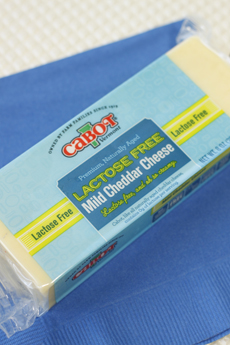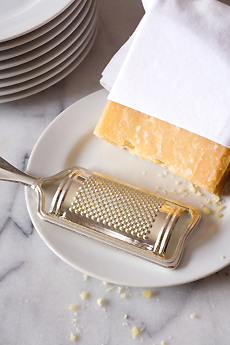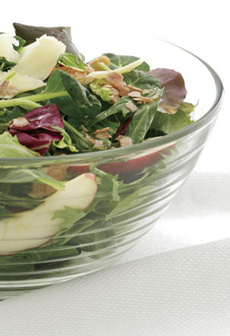
Cabot Cheddar labeled “Lactose Free.” Photo
by Elvira Kalviste | THE NIBBLE. |
|
The other day, at a social gathering, one twentysomething guest turned down a Godiva liqueur-spiked milkshake, announcing he was lactose intolerant.
“So am I,” said another guest. “Me too,” chimed a third. “And cheese was my favorite food.”
We can develop lactose intolerance at an early age: After being weaned, roughly 70% of the world’s children begin to lose the ability to make lactase, the enzyme which breaks down lactose in the intestine. This lack of lactase causes lactose intolerance. Much of it is undiagnosed, brushed off as a generic stomach ache.
Today’s tip is for anyone who may have noticed some type of digestive upset after eating cheese.
Most cheeses are 98% lactose free, but the 2% that remains can cause severe digestive problems.
There’s good news here, though: Most aged, hard cheeses are naturally lactose free, including the popular and versatile Cheddar. You might not be able to enjoy fresh goat cheese, Brie and mozzarella without side effects. But don’t lament what you can’t have: Rejoice in what you can have.
|
|
That list starts with Cheddar. In the cheese-making process, the whey, where most of the lactose resides, is drained from the curd in the milk. With hard, aged cheeses like Cheddar, the remaining 2% of the lactose is consumed in the aging process.
Since most people don’t realize this, Cabot Cheese, a Cheddar specialist, has been labeling one of its products as “Lactose Free.” That’s like labeling olive oil “Cholesterol Free,” but it’s part of the education process for the majority of people, who just don’t know.
Other cheeses to try: Colby, Swiss, Parmesan or other hard grating cheeses such as Asiago, Grana Padano and Pecorino Romano.
Note, however, that people who have zero lactase activity (are completely lactose intolerant) may not be able to eat any kind of dairy product unless it has undergone an extra step in production: a specific enzymatic process that predigests all the lactose into galactose and glucose. Green Valley makes excellent lactose-free yogurt and sour cream. More products like this are coming onto the market, but be prepared to pay a bit more for the extra time and effort required.
Do you like cottage cheese? It can range from 0 to 4 grams of lactose per half cup. You can contact the producer to see where a particular brand ranks; or you can try different brands to see which you tolerate.
Like American cheese on your burger? Switch to Cheddar or Swiss: A 1.5-ounce slice of processed American cheese can contain up to 6 grams of lactose!
|
|
LACTOSE IS HIDING IN YOUR FAVORITE FOODS
While you might expect to find milk derivatives in processed foods such as blue cheese dressing, cocoa mixes, cream soups and frostings, you may find them in unexpected places.
It’s used in breads, candies, cold cuts, cookies, dry cereals, frozen breaded fish and chicken, hot dogs and—surprise—packets of sugar substitutes, where it is used to bulk up the packets. The spoonable versions—what you’d sprinkle on cereal—have even more of it.
Beyond giveaways such as buttermilk, cream, half and half and milk, words to look for and avoid:
Lactose
Malted milk
Margarine
Milk solids
Nonfat milk solids
Sour cream
Sweet cream
Whey
Read the labels carefully.
|
|

Hard grating cheeses are lactose free. Enjoy! Photo by Yin Yang | IST. |
|
Here’s a collection of lactose education materials from the National Dairy Council.
Find more of our favorite cheeses—including lactose-free cheeses—in our Cheese Section.
|
|






